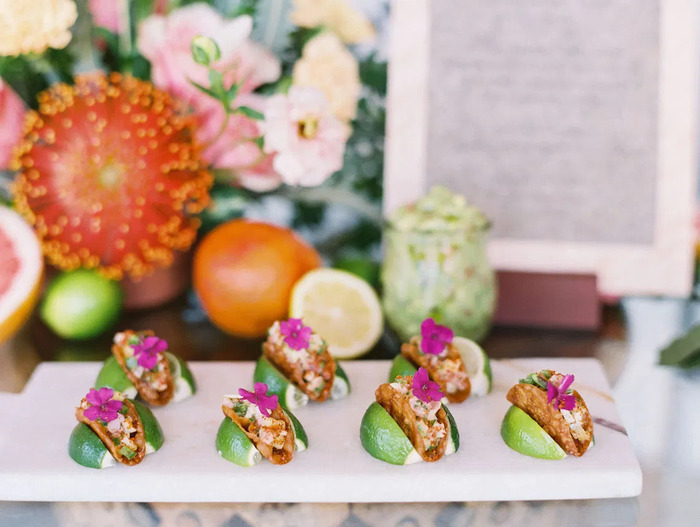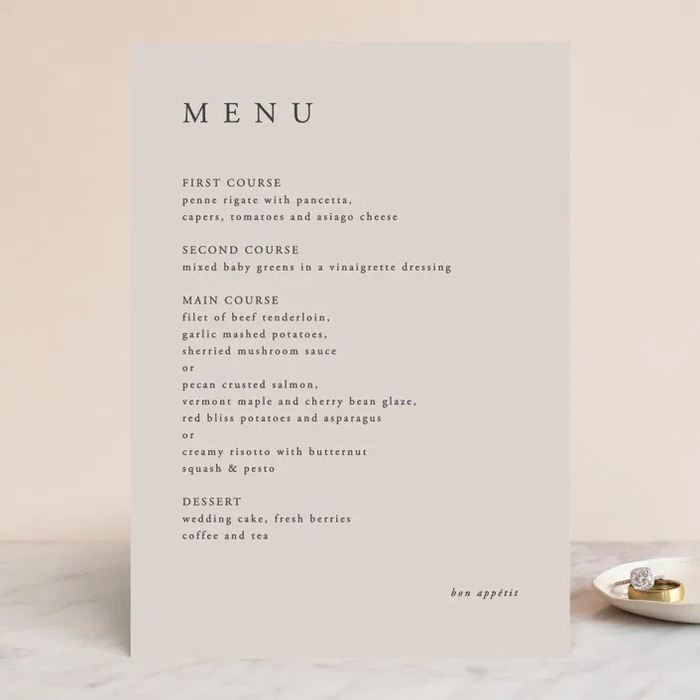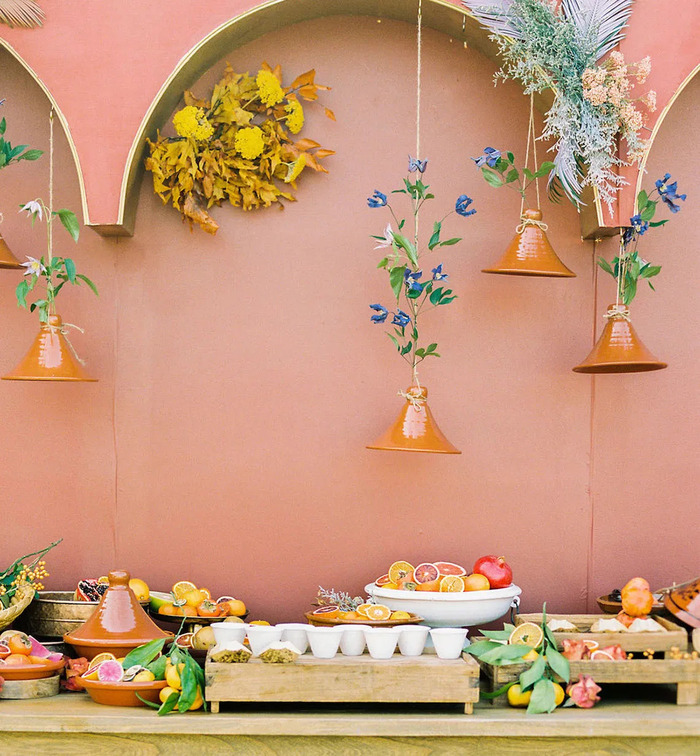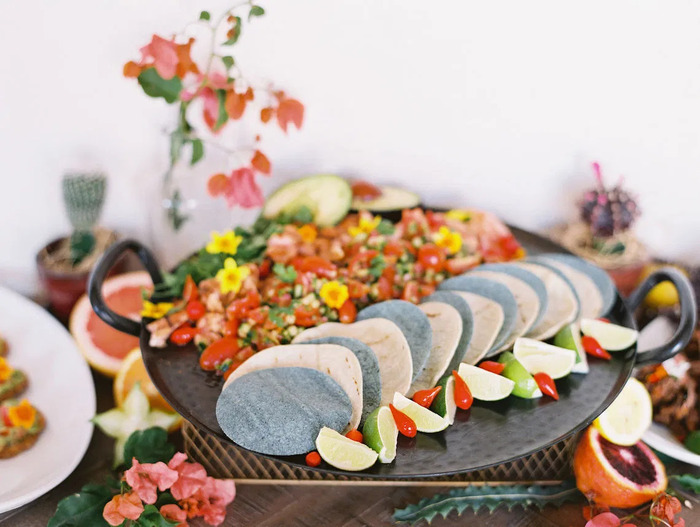La nourriture est un critère très important pour votre mariage, c’est le moment où tout le monde se réunit et profite de la compagnie des autres autour d’un beau repas. Mais pour certains, les allergies, les intolérances alimentaires ou certains régimes font de ce moment une partie stressante de la journée, et vous voulez un fabuleux dîner pour tout le monde, n’est-ce pas ? Nous avons donc rassemblé les 13 meilleures choses que vous pouvez faire pour rendre votre repas de mariage plus adapté, afin que tout le monde apprécie le dîner !

Adapté à tout le monde dès le départ
Lorsque vous préparez votre menu, veillez à prendre en compte les allergies, les intolérances ou les régimes de vos invités, y compris les offres diverses telles que végétaliennes, végétariennes et sans gluten. Les options de restriction alimentaire sur vos invitations de mariage sont également un excellent moyen de s’assurer que tout le monde soit comptabilisé.
Évitez les ingrédients problématiques
Si plusieurs de vos invités ont les mêmes restrictions alimentaires, il est généralement plus facile de demander à votre traiteur de ne pas inclure cet ingrédient dans le menu.
Communication
Fournir à vos invités des informations sur les options alimentaires et leur demander s’ils souhaitent des changements est le meilleur moyen de s’assurer que tout le monde puisse apprécier le menu. La communication est essentielle!
Personnalisations
Les restrictions et les changements alimentaires sont très courants, et il faut toujours en tenir compte lors de la préparation d’un menu. Il est donc facile de créer des plats qui évitent certains ingrédients pour vos invités. Une autre façon de s’assurer que votre menu est inclusif est d’éviter certains ingrédients sur votre menu – il y a beaucoup de personnalisations qui peuvent facilement être faites !

Pensez au menu
Pour de nombreuses personnes ayant des restrictions diététiques, comme les végétaliens, les personnes atteintes de la maladie de Crohn, tout ce qu’elles veulent, c’est un bon repas, savoureux et nutritif, qu’elles peuvent manger en toute sécurité. Cependant, la plupart du temps, on ne leur propose qu’une simple salade. Alors pourquoi ne pas faire un effort supplémentaire et s’assurer qu’ils vivent la même expérience que les autres ? La meilleure façon de procéder est de choisir des options alternatives que vous aimeriez également manger, et de vous assurer de les essayer pendant les dégustations !
Produits locaux
Les ingrédients locaux, tels que les fruits et les légumes, garantissent que votre menu est plein de saveurs et de nutriments, ce qui rend chaque plat un peu plus savoureux ! Et cela ne s’arrête pas à la nourriture, les vins et spiritueux sont souvent produits localement, vous pouvez donc demander à votre traiteur de les ajouter au menu.

Plan de table
Les plans de table sont très utiles et offrent une sécurité lorsque nous avons des invités ayant des allergies. Par exemple, si votre traiteur sait où sont assis les invités allergiques aux fruits à coque, vous pouvez faire en sorte que ces derniers n’entrent pas en contact avec un produit préparé avec des fruits à coque. Pour un service plus rationnel, vous pouvez placer les personnes ayant les mêmes allergies dans la même zone.
Menus
Placer des cartes de menu à la place de chaque invité est un excellent moyen de leur indiquer les ingrédients de chaque plat, et assurez-vous de mettre en évidence les ingrédients allergènes les plus courants afin qu’ils n’aient pas à s’inquiéter de ce qu’ils contiennent.
Il y en a pour tous les goûts
En particulier pour les canapés avant le dîner, proposez des options que tout le monde peut apprécier. Il peut s’agir d’options qui plaisent à la foule et qui tiennent compte des sensibilités alimentaires courantes, comme le végétarisme ou l’absence de gluten.

Ne réfléchissez pas trop
Si vous avez un groupe d’invités ayant des sensibilités alimentaires, ne vous compliquez pas la vie ! Il existe de nombreuses options délicieuses qui répondent à différentes intolérances et ne nécessitent pas de petites modifications.
Stations d’alimentation
Proposer différents postes de restauration permet à vos invités de choisir ce qu’ils mangent. Par exemple, une salade, des pommes de terre au four et des pâtes.
Buffets
Bien que moins formels, les buffets sont un excellent moyen de s’assurer que chacun de vos invités a quelque chose à manger. Les invités peuvent composer leur propre assiette à partir des ingrédients de leur choix. Veillez simplement à indiquer les ingrédients et les allergènes à côté de l’assiette.
Toujours partager l’information
Lorsqu’il s’agit du menu de votre mariage, il est toujours préférable de partager des informations sur la nourriture. Veillez à énumérer tous les ingrédients des plats sur leurs cartes, et vos invités pourront toujours vous appeler si aucune des options ne leur convient.

